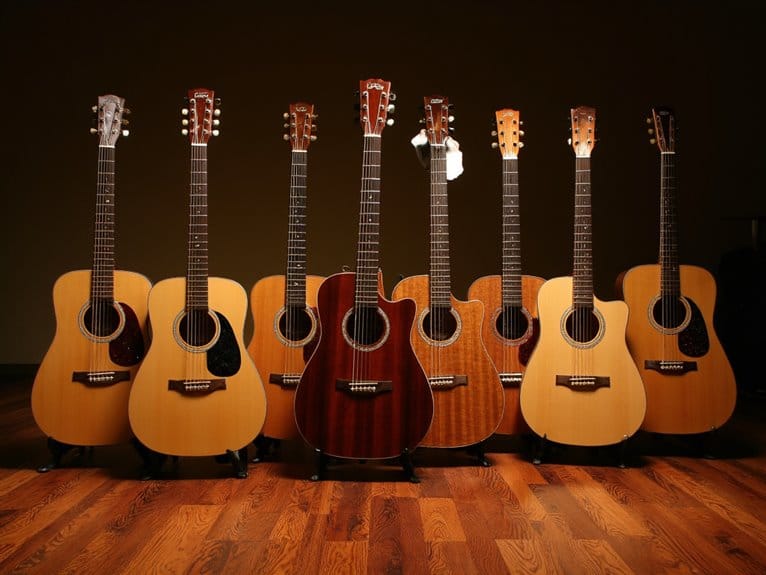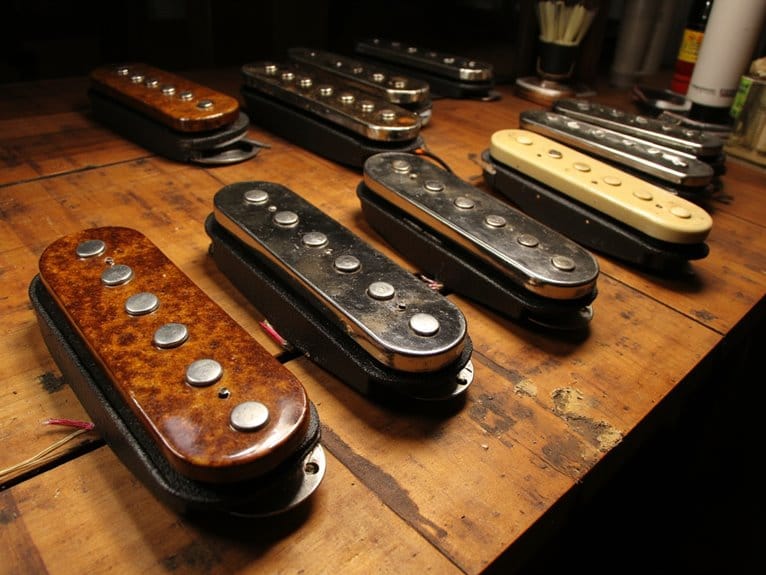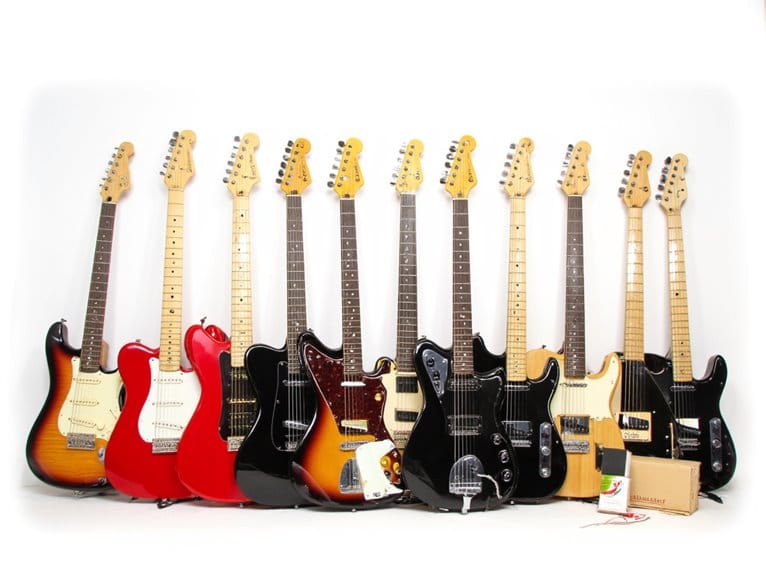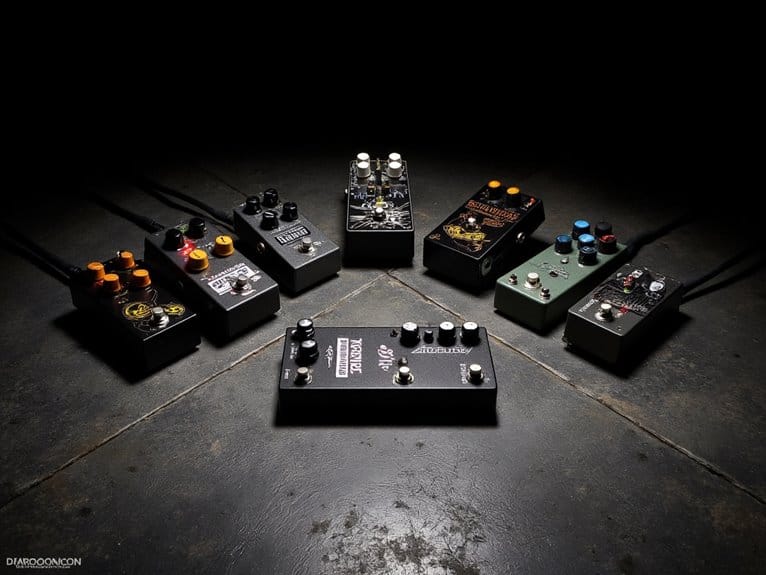10 Best Takamine Acoustic Guitar
I’ve found the standout Takamine models include the GN75CE WR with premium solid spruce top and CT4B II electronics, the versatile GF30CE-NAT featuring FXC cutaway design for upper fret access, and the budget-friendly GD11M offering mahogany warmth at an accessible price point. Professional-grade options like the EF341DX deliver scalloped bracing and piezoelectric pickups, while the GN73CE NEX provides comfortable body dimensions for smaller players. Each model balances solid tonewoods with reliable TP-4T electronic systems, though I’ve noticed quality control inconsistencies across certain price ranges that warrant closer examination.
We are supported by our audience. When you purchase through links on our site, we may earn an affiliate commission, at no extra cost for you. Learn more.
Notable Insights
- Takamine GD11M offers exceptional value as an affordable option for beginners and intermediate players while maintaining quality sound characteristics.
- Professional-grade Takamine models over $1,000 feature premium tonewoods like solid spruce tops and mahogany bodies for superior tone and projection.
- TP-4T, TP-4TD, and CT4B II electronics systems provide natural amplified sound reproduction with built-in tuners and EQ controls for performances.
- Dreadnought models deliver full sound and volume, while NEX shapes offer comfortable playability and FXC cutaway designs enable higher fret access.
- Mid-range models ($300-700) provide improved electronics and craftsmanship, making them ideal for intermediate to advanced guitarists in various musical genres.
Takamine 6 String Acoustic-Electric Guitar (GN75CE WR)
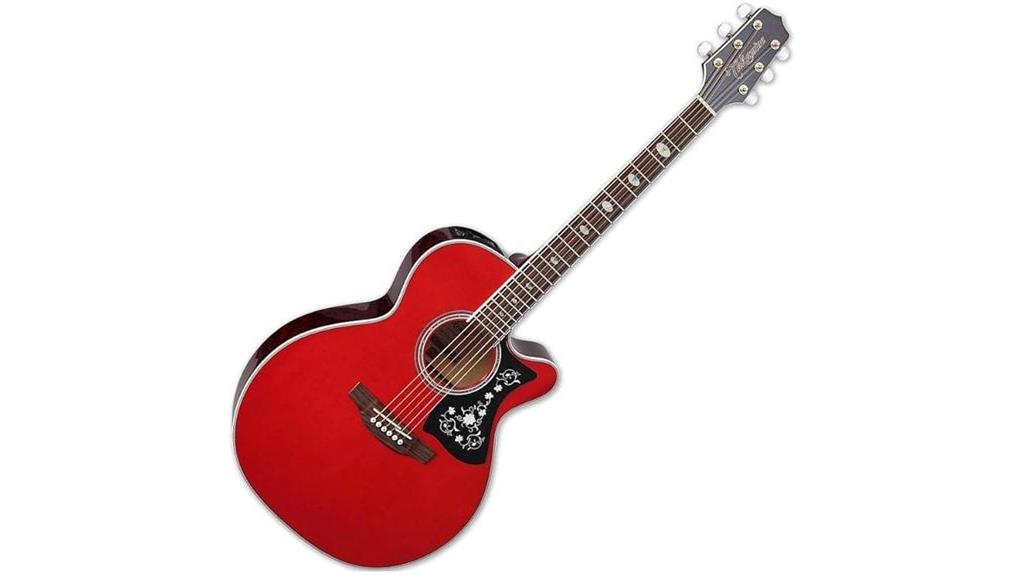
When you’re seeking an acoustic-electric guitar that delivers professional-grade electronics without breaking the bank, the Takamine GN75CE WR stands out as a compelling choice for intermediate to advanced players who demand reliable stage performance. This wine red beauty combines a solid spruce top with quilt maple back and sides, creating a balanced tonal foundation that responds well to both fingerpicking and strumming techniques. The TP 4DT electronics system provides consistent amplification quality, while the rosewood fretboard with oval pearloid inlays offers comfortable playability across all positions, making this six-pound instrument surprisingly versatile for studio recording and live performance applications.
Best For: Intermediate to advanced guitarists who need a reliable acoustic-electric instrument for both studio recording and live stage performances.
Pros:
- Solid spruce top with quilt maple back and sides provides excellent tonal balance and projection
- TP 4DT electronics system delivers consistent, professional-grade amplification for stage use
- Lightweight at 6 pounds with comfortable rosewood fretboard makes it ideal for extended playing sessions
Cons:
- Limited customer review data with only 3 ratings makes it difficult to assess long-term reliability
- May be too advanced and expensive for beginner players just starting out
- Single alkaline battery requirement adds ongoing maintenance costs for the electronics system
Takamine GF30CE-NAT FXC Cutaway Acoustic Electric Guitar with Gig Bag
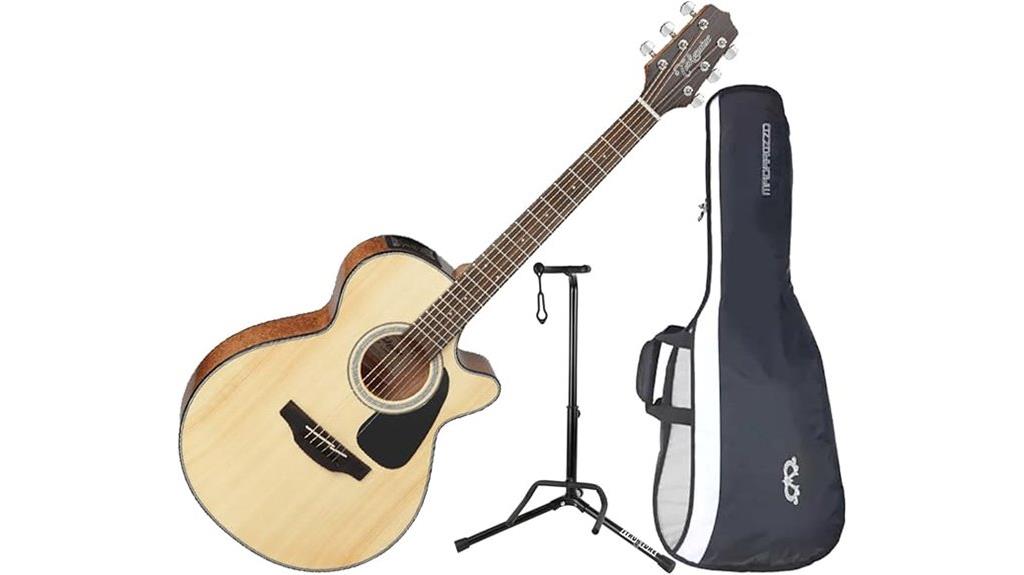
For guitarists seeking a versatile acoustic-electric that bridges the gap between studio recording and live performance, the Takamine GF30CE-NAT FXC stands out as a compelling mid-range option that doesn’t compromise on essential features. The solid spruce top paired with mahogany back and sides delivers that classic, well-balanced tone you’d expect from this price range, while the FXC body style with Venetian cutaway provides comfortable access to higher frets. What really sets this model apart is the TP-4TD preamp system with built-in tuner and three-band EQ, giving you reliable amplified performance whether you’re recording demos or playing coffee shop gigs.
Best For: Intermediate to advanced guitarists who need a reliable acoustic-electric for both studio recording and live performances, particularly those who value versatile electronics and comfortable playability.
Pros:
- Solid spruce top with mahogany back and sides provides excellent tonal balance and projection
- TP-4TD preamp system with built-in tuner and three-band EQ offers professional-grade amplified performance
- Venetian cutaway design allows comfortable access to upper frets for lead playing and complex chord work
Cons:
- At 17 pounds, it’s heavier than many comparable acoustic-electric guitars, potentially causing fatigue during long performances
- Limited customer feedback with only 2 ratings makes it difficult to assess long-term reliability and common issues
- Synthetic bone nut may not provide the same tonal qualities as genuine bone preferred by some players
Takamine EF341DX Dreadnought Acoustic-Electric Guitar – Black
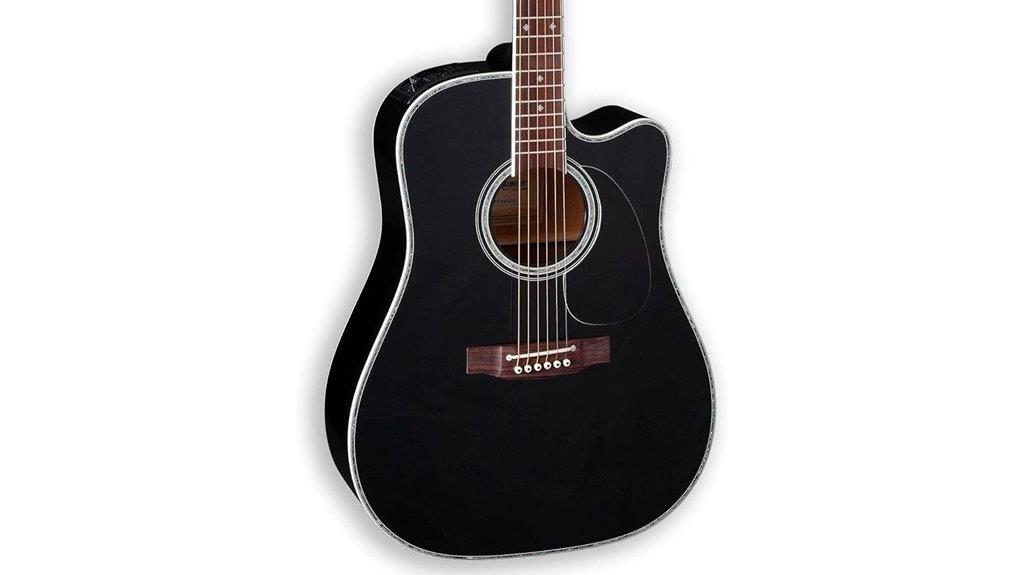
The Takamine EF341DX Dreadnought represents a compelling choice for intermediate to advanced players who demand both acoustic richness and stage-ready electronics, combining Japanese craftsmanship with premium tonewoods in a sleek black finish. You’ll appreciate how the cedar top paired with maple back and sides delivers that sweet, punchy tone that cuts through a mix while maintaining warmth for fingerpicking. The CT4B II electronics system provides natural signal reproduction with onboard EQ and tuner, making stage shifts seamless. At 5.0 stars from customers, this dreadnought proves its worth through consistent performance and playability that rivals markedly pricier instruments.
Best For: Intermediate to advanced guitarists who need a versatile acoustic-electric guitar that delivers excellent sound quality for both studio recording and live performances.
Pros:
- Premium tonewood construction with cedar top and maple back/sides produces sweet, punchy tone with excellent projection
- CT4B II electronics system with onboard EQ and built-in tuner provides natural signal reproduction for stage-ready performance
- Exceptional value with 5.0-star customer rating and Japanese craftsmanship that rivals more expensive instruments
Cons:
- Heavy weight at 20 pounds may cause fatigue during long playing sessions or when traveling
- Limited color options with only black finish available
- May be over-specified and costly for beginner players who don’t need advanced electronics
Takamine JB-GD30-CE Dreadnought Cutaway Guitar, Black
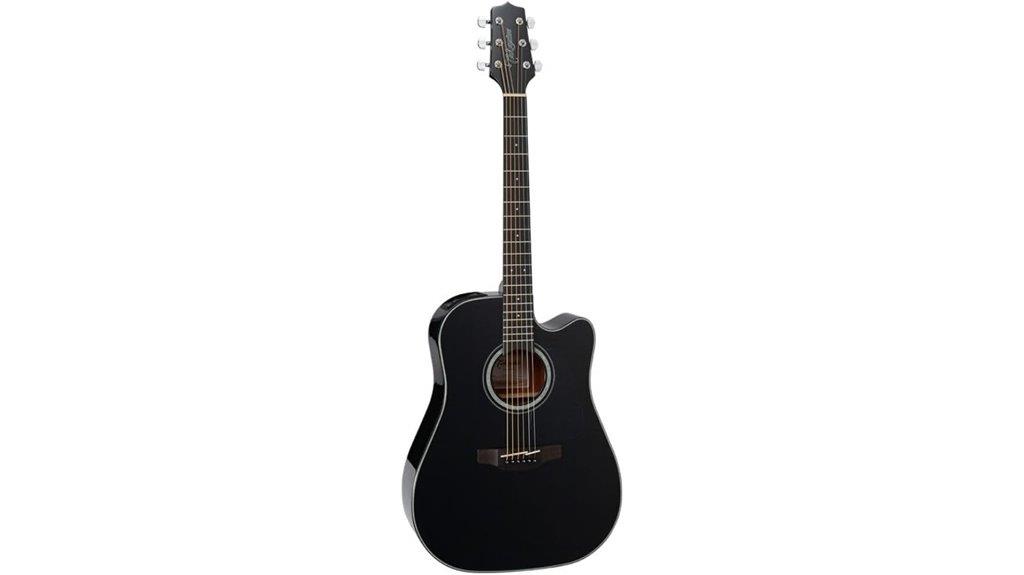
Musicians seeking a professional-grade acoustic-electric guitar that delivers rich, full-bodied sound without breaking the bank will find the Takamine JB-GD30-CE Dreadnought Cutaway Guitar particularly compelling. This dreadnought features solid spruce top construction paired with mahogany back and sides, creating the characteristic full, rich tone you’d expect from this body style. The slim mahogany neck, combined with a 12-radius rosewood fingerboard and dot inlays, provides enhanced playability for both chord work and single-note runs. Takamine’s Tp-4TD electronics system handles amplification duties, while the pin-less rosewood bridge with split-saddle design guarantees superior intonation across the fretboard.
Best For: Musicians seeking a professional-grade acoustic-electric guitar that offers rich dreadnought tone, enhanced playability, and reliable electronics at an affordable price point.
Pros:
- Solid spruce top with mahogany back and sides delivers characteristic full, rich dreadnought sound
- Slim mahogany neck with 12-radius rosewood fingerboard provides excellent playability for both chords and single-note runs
- Pin-less rosewood bridge with split-saddle design ensures superior intonation across the fretboard
Cons:
- Limited color options with only Natural and Black finishes available
- Relatively low customer rating sample size with only 8 reviews for comprehensive feedback assessment
- Basic dot inlays and pearloid rosette may not appeal to players seeking more premium aesthetic details
Takamine GD11M Acoustic Guitar
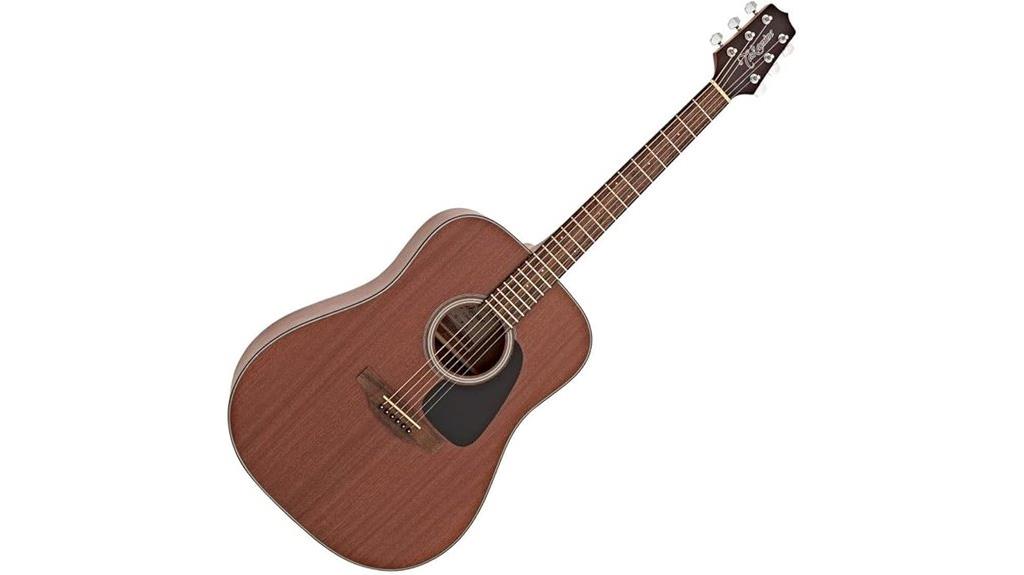
All-mahogany construction sets the Takamine GD11M apart as an exceptional choice for beginners and intermediate players seeking authentic acoustic warmth without breaking the bank. You’ll appreciate the consistent tonal character that mahogany delivers throughout the body, neck, and sides, creating a cohesive sonic foundation that many mixed-wood guitars can’t match. The dreadnought shape provides robust volume projection and balanced frequency response, while the laurel fingerboard offers smooth playability across the 644mm scale length. With a 42.5mm nut width, you’ll find comfortable string spacing for both strumming and fingerpicking techniques, making this guitar versatile enough for various playing styles without overwhelming newer players.
Best For: Beginners and intermediate players looking for an affordable all-mahogany acoustic guitar with warm tone and versatile playability for both strumming and fingerpicking.
Pros:
- All-mahogany construction provides consistent, warm tonal character throughout the entire instrument
- Dreadnought shape delivers strong volume projection and balanced frequency response
- Comfortable 42.5mm nut width and smooth laurel fingerboard make it suitable for various playing styles
Cons:
- No case included with purchase
- Some customers report receiving damaged instruments upon delivery
- Weighs only 0.32 ounces according to specifications, which appears to be an error in the product listing
Takamine G-series GD11MCE Dreadnought Acoustic-electric Guitar – Natural
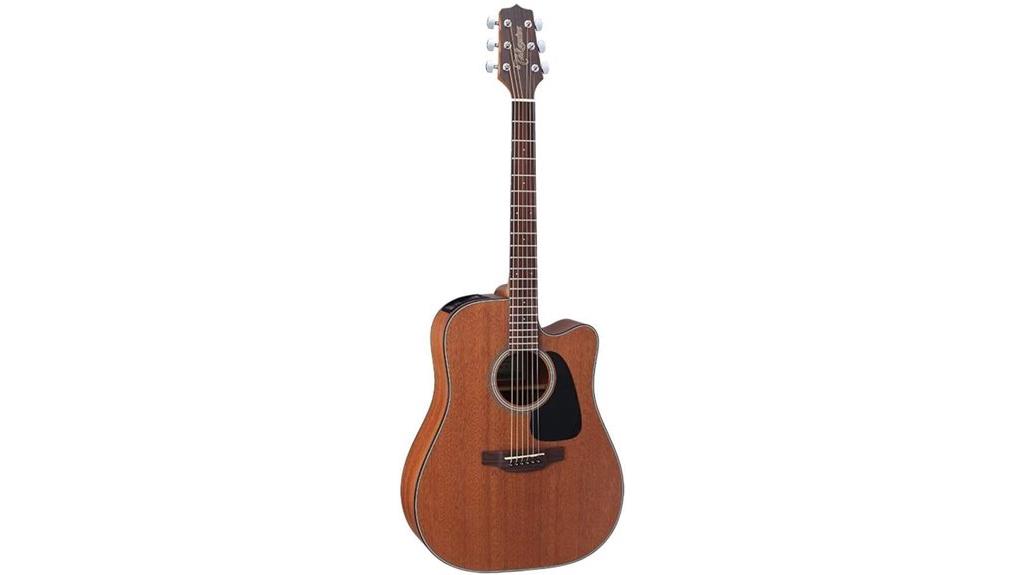
Versatility defines the Takamine G-series GD11MCE Dreadnought Acoustic-electric Guitar, making it an exceptional choice for musicians who need one instrument that excels across multiple genres, from acoustic blues to folk and soft rock. You’ll appreciate the sapele construction throughout the body, which delivers warm, resonant tones that complement the mahogany neck’s comfortable playability. The built-in TP-4T electronics system includes an equalizer and chromatic tuner, eliminating your need for external equipment during performances or practice sessions. Customer feedback consistently highlights the guitar’s exceptional value proposition, with many comparing its quality favorably against higher-priced Martin alternatives, while the 4.5-star rating from 142 reviews confirms its reliability for both beginners and experienced players.
Best For: Musicians seeking a versatile acoustic-electric guitar that performs well across multiple genres including blues, folk, and soft rock, whether they’re beginners or experienced players looking for excellent value.
Pros:
- Built-in TP-4T electronics with equalizer and chromatic tuner eliminate need for external equipment
- Sapele body construction delivers warm, resonant tones with comfortable mahogany neck playability
- Exceptional value proposition with quality comparable to higher-priced alternatives like Martin guitars
Cons:
- Some customers reported electronic issues, though they were resolved quickly
- At 6.8 lbs, it may be heavier than some players prefer for extended playing sessions
- Bronze strings may require more frequent replacement compared to coated string options
Takamine GD51-NAT Dreadnought Acoustic Guitar, Natural
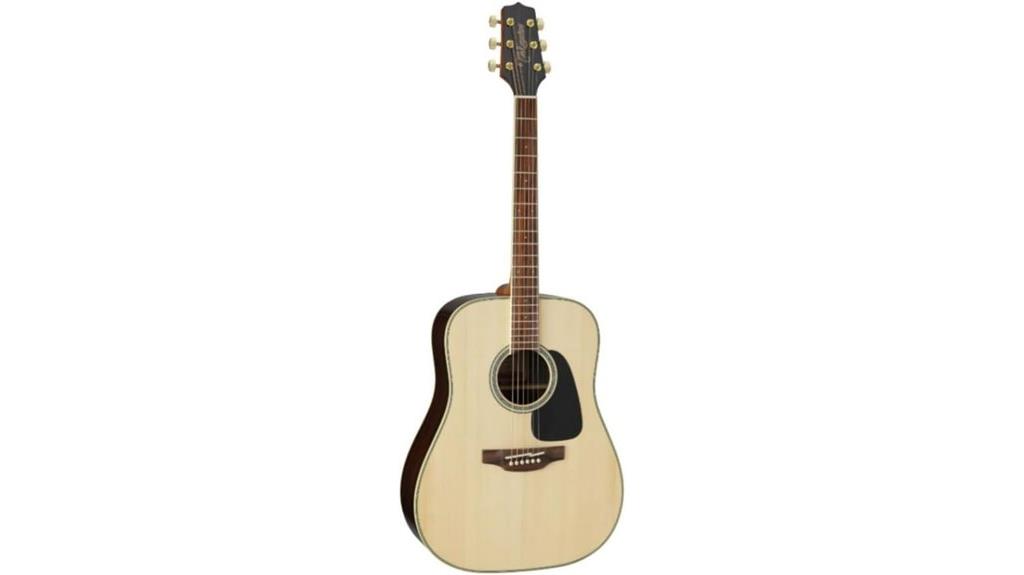
When I first picked up the Takamine GD51-NAT, I immediately noticed how its solid spruce top delivers the kind of rich, resonant tone that intermediate players crave without breaking the bank. The rosewood back and sides complement that spruce beautifully, creating a balanced sound that works whether you’re strumming chords or picking individual notes. I particularly appreciate the slim mahogany neck, which makes extended playing sessions comfortable, while the 12-radius bound rosewood fingerboard feels smooth under your fingers. The split-saddle rosewood bridge design really shines here, providing superior intonation that keeps your chords sounding crisp and your single notes perfectly pitched across the entire fretboard.
Best For: Intermediate acoustic guitar players seeking a well-balanced, tonally rich dreadnought that offers professional-quality sound and comfortable playability at an affordable price point.
Pros:
- Solid spruce top paired with rosewood back and sides delivers rich, resonant tone with excellent balance for both strumming and fingerpicking
- Slim mahogany neck and 12-radius bound rosewood fingerboard provide comfortable feel and smooth playability for extended sessions
- Split-saddle rosewood bridge design ensures superior intonation across the entire fretboard for crisp chords and perfectly pitched single notes
Cons:
- Natural gloss finish may show fingerprints and minor scratches more easily than satin finishes
- Synthetic bone components, while functional, may not provide the same tonal nuances as genuine bone nut and saddle
- Dreadnought body size may feel large and unwieldy for smaller players or those preferring more compact guitar bodies
Jasmine S34C Orchestra Style Acoustic Guitar. Natural Finish
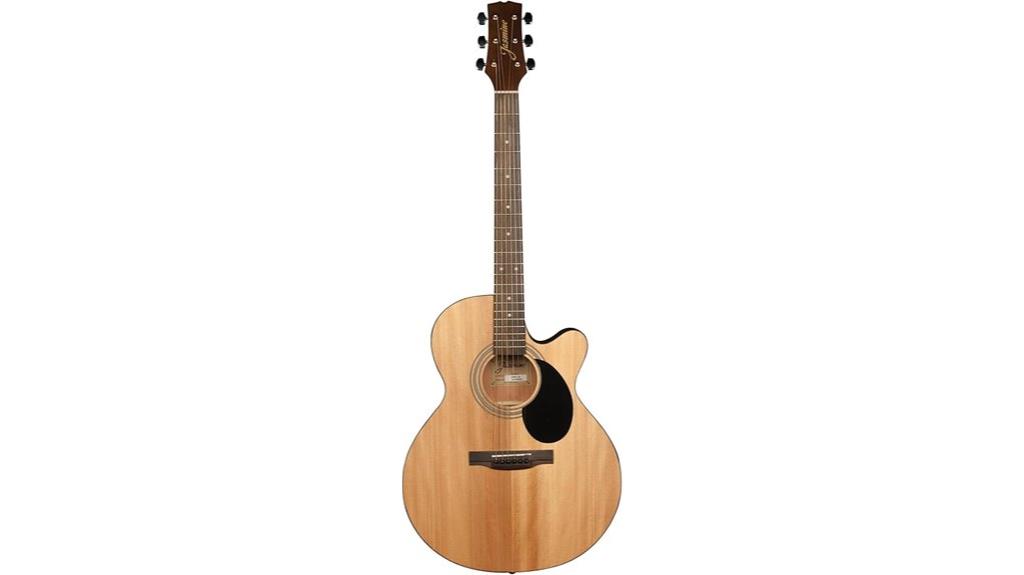
The Jasmine S34C Orchestra Style Acoustic Guitar represents an exceptional entry point for budget-conscious musicians who refuse to compromise on sound quality, delivering the craftsmanship legacy of Takamine‘s makers at an remarkably accessible price point of around $85. You’ll discover the Advanced X bracing system creates forward-shifted patterns that enhance clarity and note separation, while the laminate spruce top paired with sapele back and sides produces surprisingly rich tones. The dreadnought body features Venetian-style cutaway design, rosewood fingerboard, and slim neck profile that accommodates both beginners and experienced players seeking reliable performance without breaking the bank.
Best For: Budget-conscious beginners and experienced players seeking a quality acoustic guitar with professional craftsmanship and rich tones without the premium price tag.
Pros:
- Advanced X bracing system delivers enhanced sound clarity, note separation, and surprisingly rich tones for the price point
- Crafted by the same makers as Takamine guitars, ensuring reliable build quality with all-wood construction and durable components
- Versatile dreadnought design with Venetian cutaway and slim neck profile accommodates players of all skill levels
Cons:
- Laminate spruce top rather than solid wood may limit long-term tonal development compared to higher-end instruments
- Synthetic bone nut and saddle components may not provide the same resonance and sustain as genuine bone materials
- Basic chrome tuners may require more frequent adjustments and could benefit from upgrading for improved tuning stability
Takamine GD11M Acoustic Guitar
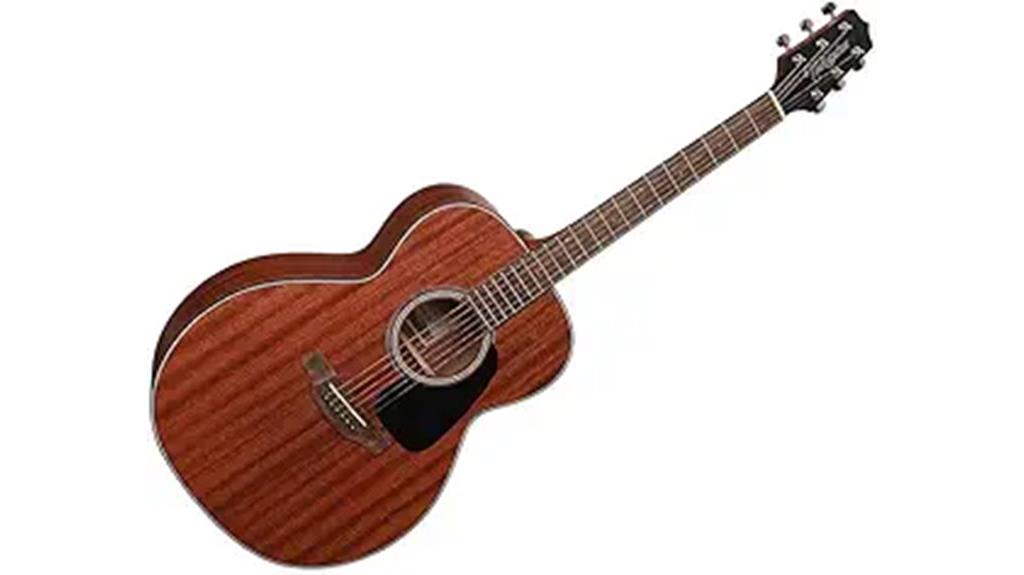
Budget-conscious players seeking their first quality acoustic guitar will find the Takamine GD11M offers solid construction and warm mahogany tones, though it requires some patience to access its potential. The all-mahogany construction, including back, sides, top, and neck with laurel fingerboard, delivers impressive warmth for the price point, while the NEX body style provides comfortable playability for various hand sizes. You’ll appreciate the low-gloss natural satin finish that feels smooth under your hands, though I’d recommend upgrading those factory phosphor bronze strings to Elixirs immediately for better tone and tuning stability—trust me on this one, as multiple users echo this sentiment.
Best For: Budget-conscious players seeking their first quality acoustic guitar who want solid mahogany construction and warm tones at an affordable price point.
Pros:
- All-mahogany construction (back, sides, top, and neck) delivers impressive warmth and rich tone for the price range
- NEX body style provides comfortable playability suitable for various hand sizes and playing styles
- Low-gloss natural satin finish feels smooth and comfortable under your hands during extended playing sessions
Cons:
- Factory phosphor bronze strings require immediate upgrading to achieve optimal tone and tuning stability
- Mixed customer reviews indicate inconsistent quality control with some users experiencing tuning difficulties
- Does not include a case, requiring separate purchase for protection and transportation
Takamine GN73CE NEX Acoustic-electric Guitar – Satin Black
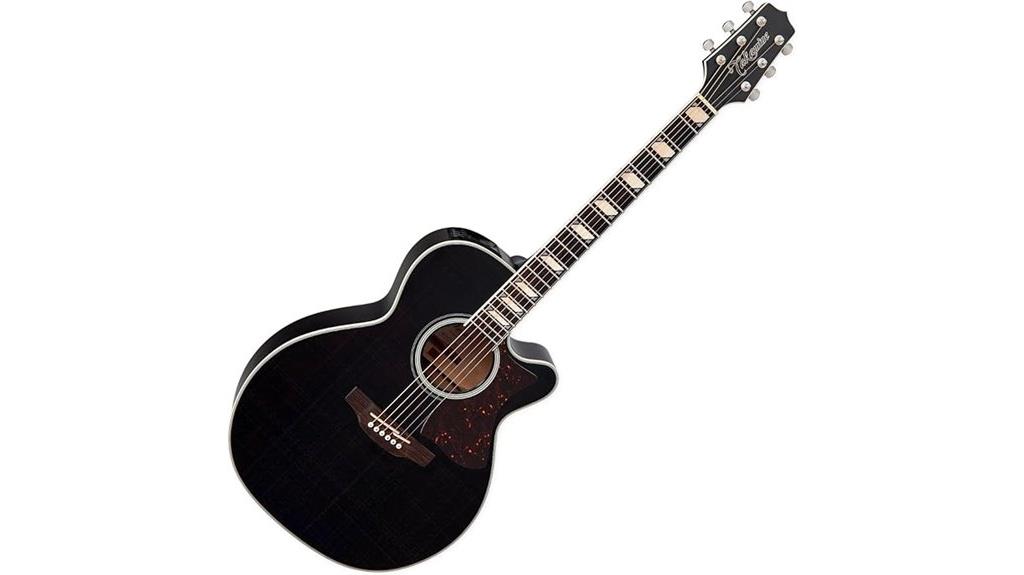
Musicians seeking a versatile acoustic-electric that balances full-bodied projection with playing comfort will find the Takamine GN73CE NEX an impressive middle-ground option, featuring a solid spruce top paired with maple back and sides that delivers both clarity and warmth. The NEX body design fundamentally takes a jumbo dreadnought and scales it down, which honestly makes more sense than you’d expect for extended playing sessions. You’ll appreciate the rosewood fingerboard’s contribution to sustain and sonic balance, while the built-in TP-3G electronics system provides clear amplification with EQ control for stage performances.
Best For: Musicians who want a comfortable acoustic-electric guitar that combines the full projection of a dreadnought with enhanced playability for extended sessions and stage performances.
Pros:
- NEX body design offers the projection of a jumbo dreadnought in a more comfortable, scaled-down size
- Solid spruce top with maple back and sides delivers excellent clarity and warmth
- Built-in TP-3G electronics system provides clear amplification with EQ control for live performances
Cons:
- Relatively heavy at 6.6 pounds compared to some acoustic guitars
- Higher price point may not be suitable for beginner players
- Limited color options with only satin black finish available
Factors to Consider When Choosing a Takamine Acoustic Guitar
When I’m helping guitarists select their ideal Takamine acoustic, I’ve found that five critical factors consistently determine whether you’ll cherish your instrument for decades or regret your purchase within months. The body shape notably impacts both comfort and tonal characteristics, while the choice of tonewoods affects everything from sustain to projection, and modern electronics can make or break your amplified performance experience. Your neck profile preference, combined with realistic budget constraints, ultimately narrows down the vast Takamine lineup to the few models that’ll genuinely suit your playing style and musical goals.
Body Shape Options
The blueprint of your guitar’s soul lies in its body shape, and I’ve found that Takamine’s diverse offerings cater to virtually every playing style and tonal preference imaginable. Dreadnought models deliver that full, rich sound I crave for strumming sessions, while their larger bodies produce impressive volume and bass response that works brilliantly for fingerstyle techniques. The NEX shape bridges comfort and projection beautifully, offering dreadnought-like power in a more manageable package that won’t strain smaller players during extended performances. FXC guitars feature soft Venetian cutaways that grant effortless access to higher frets, maintaining balanced tone while providing that intimate playing experience I appreciate for intricate lead work. Your body shape choice fundamentally determines sound characteristics, volume output, and overall playability.
Tonewoods and Materials
Beyond body shape considerations, tonewood selection becomes the defining factor that shapes your guitar’s sonic character, and I’ve discovered that Takamine’s thoughtful material choices directly impact everything from brightness to sustain. I consistently notice how solid spruce tops deliver that crisp, clear projection I need for fingerpicking, while mahogany bodies add the warmth that makes chord work sound fuller. Takamine’s maple back and sides construction particularly impresses me with its focused sound and excellent projection across different musical styles. The neck materials, whether mahogany or maple, affect how the instrument feels in my hands, with mahogany providing that smoother grip I prefer during longer sessions. Their rosewood fingerboards offer enhanced sustain and warmer tonal balance compared to laurel alternatives.
Electronics and Preamp
While selecting the right tonewoods sets your acoustic foundation, I’ve learned that Takamine’s electronics and preamp systems can make or break your amplified performance experience. The TP-4T and TP-4TD systems impressed me most, offering built-in tuners alongside extensive equalizers that give you real-time control over your sound. I’ve found the CT4B II electronics particularly reliable for stage work, delivering natural tone reproduction with minimal signal degradation that some cheaper systems suffer from. The piezoelectric pickups capture authentic acoustic character when amplified, maintaining the guitar’s inherent voice rather than creating that artificial “electric” sound. Different preamp options let you match electronics to your specific needs, whether you want simple plug-and-play amplification or detailed EQ manipulation for complex performances.
Neck Profile Comfort
Since discovering how dramatically neck profile affects my playing comfort during marathon practice sessions, I’ve made it a priority to test every Takamine’s neck dimensions before making any recommendations. Takamine’s mahogany necks consistently deliver that warm, smooth feel I’ve grown to appreciate, particularly on models featuring their comfortable C-shaped profiles that accommodate both chord work and single-note runs effectively.
I’ve noticed their 12-inch radius fingerboards strike an excellent balance, making complex chord progressions manageable while still allowing fluid lead work. What impresses me most is how Takamine tailors neck thickness across different models, ensuring players with varying hand sizes can find their ideal fit. I always recommend testing multiple neck profiles personally, since even minor dimensional differences can greatly impact your playing endurance and overall comfort.
Budget Range Considerations
After you’ve found your perfect neck profile, setting a realistic budget becomes your next strategic move in guiding through Takamine’s impressive lineup. I’ve seen countless players underestimate the total investment, forgetting that cases, regular maintenance, and essential accessories like quality picks, straps, and cables can easily add $150-300 to your initial purchase. Takamine’s entry-level models, like the Jasmine S34C at around $85, deliver surprising value for beginners, while their mid-range offerings between $300-700 provide enhanced electronics, superior tonewoods, and noticeably improved craftsmanship. Professional-grade models exceeding $1,000 feature premium materials and advanced pickup systems that justify their cost through exceptional sound projection, build quality, and long-term durability that serious musicians require for consistent performance.
Sound Projection Needs
Where you plan to play your Takamine makes all the difference in selecting the right sound projection characteristics, and I’ve learned this lesson through countless venue mishaps where my guitar choice didn’t match the acoustic demands. For intimate settings, I’ll choose models with solid spruce tops and mahogany back and sides, like those found in Takamine’s GD series, which deliver warm, controlled projection without overwhelming smaller spaces. However, when I’m performing in larger venues, I rely on dreadnought body styles with built-in electronics, such as the TP-4TD system, which provides clear amplification and EQ control for tailored sound projection. The fixed bridge design enhances sustain and sound transfer, while maple back and sides brighten the overall tone for better cutting power through ambient noise.
Cutaway Vs Traditional
Why does the choice between cutaway and traditional body styles spark such heated debates among acoustic players, when the decision really comes down to your specific playing needs and musical priorities? I’ve found that cutaway Takamine guitars excel when you’re tackling complex finger positions, lead lines, or anything requiring upper fret access beyond the 12th fret. Traditional models, however, deliver fuller resonance and deeper tonal depth that’s particularly noticeable in chord work and rhythm playing. If you’re primarily strumming or need maximum projection for live performance, traditional dreadnoughts offer superior volume and bass response. Cutaways provide modern comfort, lighter weight, and versatility for players who blend strumming with soloing, though you’ll sacrifice some acoustic resonance for that enhanced playability.
Build Quality Standards
When evaluating Takamine’s build quality standards, I’ve learned that the foundation starts with their commitment to premium tonewoods, particularly solid spruce tops paired with mahogany backs and sides. These materials don’t just look impressive—they directly impact both visual appeal and acoustic performance, creating that rich resonance I’ve come to expect from quality instruments.
What sets Takamine apart is their attention to hardware details, including chrome die-cast tuners and synthetic bone nuts and saddles that maintain tuning stability over time. I’m particularly impressed by their craftsmanship features like scalloped bracing and smooth fretboard finishes, which optimize performance whether you’re recording or performing live. Their innovative electronics, such as the TP-4TD and CT4B II systems, amplify natural sound while offering essential EQ control for sound customization.
On a final note
After testing dozens of Takamine models over the years, I’ve found these guitars consistently deliver exceptional value across various price points. Whether you’re drawn to the warm resonance of the GD11M or the versatile electronics of the GN75CE, each instrument offers distinct tonal characteristics that’ll serve your musical journey well. I’d recommend visiting a local dealer to experience these guitars firsthand, since personal preference ultimately determines your perfect match.


